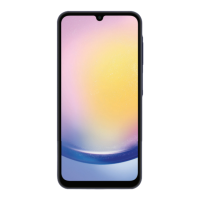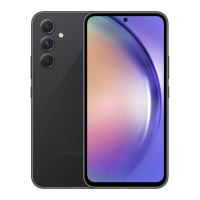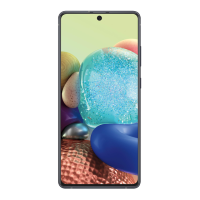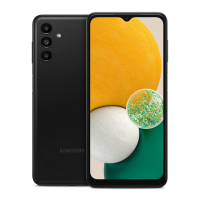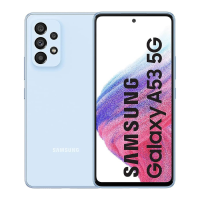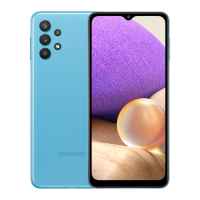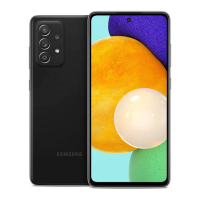Do you have a question about the Samsung Galaxy A22 5G and is the answer not in the manual?
Details on terminal usage, radio wave penetration, and communication security.
Guidelines to protect users and property, with hazard level symbols.
Safe handling of the terminal, adapter, and nanoUIM card to prevent hazards.
Explains IPX5, IPX8, IP6X ratings and how to maintain terminal's water/dust resistance.
Identifies and describes the physical parts and buttons of the terminal.
Information about the nanoUIM card for user information and phone numbers.
Details on attaching and using microSD cards for storage expansion.
Instructions and precautions for charging the terminal's internal battery.
Steps to turn the terminal on, off, and manage the screen lock.
Guides through the initial setup process for language, accounts, and services.
Explains PIN, PUK, network security codes, and screen lock settings.
Explains touch gestures like tap, drag, swipe, and pinch for terminal operation.
Describes the functions of navigation bar icons (History, Home, Back).
How the terminal automatically switches screen orientation based on device tilt.
Instructions on how to take screenshots of the terminal's display.
How to enable Emergency mode to conserve battery and its functions.
Using device movements for specific actions like waking or turning off the screen.
How to input text using the on-screen keyboard and its features.
Customizing text input and conversion settings for the keyboard.
Explains icons in the status bar indicating terminal status and notifications.
Details the components and functionality of the notification panel.
How to keep frequently used apps visible on the screen.
Demonstrates how to use split screen view with sample apps.
Configuring motion and voice controls for terminal operations.
How to change the default home screen application.
Instructions for moving and rearranging app icons on the Home screen.
How to remove or disable applications from the terminal.
How to use the recommended apps feature based on usage.
Guide to navigating and using the my daiz NOW service screen.
How to enable, add, and configure edge panels for quick app access.
Visual guide to Home screen elements like widgets and shortcuts.
How to remove or disable applications from the terminal.
A comprehensive list of installed applications and their functions.
Instructions for dialing phone numbers and initiating calls.
Important notes and procedures for making emergency calls.
How to answer or reject incoming voice and video calls.
Controls and features available during a video call.
How to view and manage call history logs.
Setting up an answering machine for missed calls.
Instructions for making international calls using the WORLD CALL service.
Configuration options for various calling services and preferences.
Registering numbers to block calls and SMS from.
How to find and modify contact information in the phonebook.
Sending and receiving emails using the docomo mail service.
Sending and receiving text messages, images, and stamps via the +Message app.
How to view messages organized into conversation threads.
Removing individual messages from a conversation.
Configuring email accounts for sending and receiving emails.
Steps for composing and sending emails using Gmail.
Configuring settings for receiving emergency alerts and notifications.
How to browse websites on the terminal using the web browser.
How to view browsing history and manage website bookmarks.
Information and precautions before using the camera.
Interface and controls for taking still images and videos.
Steps and tips for capturing still photographs.
Instructions for recording video clips.
Customizing camera settings and shooting modes.
How to take portrait photos with blurred backgrounds.
Utilizing augmented reality features like AR Emoji and Doodle.
How to view and manage video files.
Accessing DOCOMO recommended sites and useful apps via dmenu.
Step-by-step guide to downloading and installing applications from the Play Store.
How to access and download apps from the Galaxy Store.
How to use Osaifu-Keitai for payments and loyalty programs.
Enabling GPS and precautions for using location-based services.
Setting and managing alarms, including snooze functionality.
How to register events and tasks in the calendar.
Steps to create, edit, and save notes with text, drawings, and files.
How to play back recorded voice memos.
Using the calculator for arithmetic and other functions.
Transferring data between terminals directly or via the internet.
Accessing and managing health-related data within S Health.
Overview of the main settings categories and their corresponding page numbers.
Connecting to Wi-Fi networks for internet access.
Managing NFC and Osaifu-Keitai functions for payments and data reading.
Enabling Airplane mode to disable all wireless connections.
Limiting background data usage by apps to save data.
Using the terminal as a Wi-Fi hotspot to share internet connection.
Steps to add a VPN profile for secure network access.
Configuring sound and vibration settings for different call and notification modes.
Choosing and setting custom ringtones for incoming calls.
Enabling dark mode for comfortable viewing and battery saving.
How to choose and apply wallpapers for the Home and lock screens.
Customizing the terminal's appearance by applying themes, wallpapers, and icons.
Setting up different methods to unlock the terminal screen.
Tracking and managing the device remotely via Find My Mobile service.
Unlocking the terminal using facial recognition technology.
Managing app permissions to control access to device features.
Setting up and managing the DOCOMO account for services.
Configuring various Google services and settings on the terminal.
Adding, managing, and removing accounts linked to the terminal.
Monitoring and managing screen time usage for apps and the terminal.
Displaying battery status, usage, and power-saving options.
Scanning the device for security threats and malware.
Setting the terminal's date, time, and time zone automatically or manually.
Restoring the terminal to its default factory settings, erasing all data.
Enabling screen reader functionality for visually impaired users.
Instructions for downloading and installing software updates for the terminal.
How to find and view your own phone number and device information.
Overview of the default folder structure for internal and external storage.
How to change the names of files and folders within My Files.
Transferring data wirelessly between the terminal and Bluetooth devices.
How to send and receive files and contacts using Bluetooth.
Using NFC for proximity communication, mobile payments, and data reading.
Connecting the terminal to a PC for data synchronization and media device recognition.
How to print wirelessly or via USB connection from the terminal.
Connecting to compatible devices for screen mirroring and content display.
Information about using the terminal overseas with the WORLD WING service.
Pre-travel checks for using the terminal overseas, including subscription and usage fees.
How to make and receive calls while roaming internationally.
Configuring data roaming and network operator settings for international use.
Configuring automatic country code and prefix for international calls.
Common problems and their solutions for terminal operation, charging, and power issues.
Troubleshooting issues related to making calls, ringtones, and network connectivity.
Troubleshooting display issues like dimming or screen timeout.
Troubleshooting audio issues during calls, like volume problems.
Troubleshooting issues with receiving mail automatically.
Instructions and precautions for updating the terminal's software.
Details on warranty terms, conditions for free repair, and after-sales service.
Technical specifications of the phone, including dimensions, display, memory, and battery.
Information on SAR compliance with Japanese and international guidelines.
Compliance information regarding FCC rules and potential radio interference.
Guidelines for body-worn operation to meet FCC RF exposure requirements.
Information on export regulations applicable to the product and its accessories.
Explains copyright laws related to music, video, and software usage.
| RAM | 4GB / 6GB / 8GB |
|---|---|
| Storage | 64GB / 128GB, expandable via microSDXC |
| Rear Camera | 48 MP (wide) + 5 MP (ultrawide) + 2 MP (depth) |
| Front Camera | 8 MP |
| Operating System | Android 11, One UI Core 3.1 |
| Dimensions | 167.2 x 76.4 x 9 mm (6.58 x 3.01 x 0.35 in) |
| Weight | 203 g (7.16 oz) |
| Network | GSM / HSPA / LTE / 5G |
| Colors | Gray, White, Mint, Violet |
| Display | 6.6 inches, TFT, 1080 x 2400 pixels |
| Processor | MediaTek Dimensity 700 |
| Battery | 5000 mAh |

